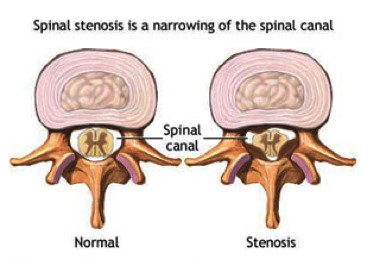Lumbar Spinal Stenosis. Big words for an unbelievably common problem. Lumbar spinal stenosis is a condition affecting the lower back where the spinal cord one or more of the vertebral foramina become narrowed due to one of several causes. It is painful and causes pain, weakness, and numbness in the lower extremities. Read on to learn more about this condition.
What exactly is this condition?
The lumbar area is the lower back, specifically made up of five vertebrae in the lower back area. The spinal cord runs through the spinal canal and nerves come off the spinal cord and exit through small openings in the vertebrae called foramina. These nerves control the sensations and movement in the lower extremities – buttocks, legs, toes, etc. Sometimes, the spinal canal or the vertebral foramina narrow and begin to put pressure on the spinal cord and the nerves. This causes pain, numbness, and weakness possibly diagnosed as lumbar spinal stenosis.
What causes lumbar spinal stenosis?
According to the Mayo Clinic, some people are born with a small spinal canal, but most spinal stenosis occurs when something happens to reduce the amount of space the spinal cord or the nerves have available. It is most commonly diagnosed in people over the age of 50. Some causes are:
- Overgrowth of bone – wear and tear on the bones of the spinal column can sometimes cause osteoarthritis to develop and bone spurs to grow into the spinal canal. This is the leading cause of lumbar spinal stenosis.
- Herniated disks – the disks between the vertebrae wear out with age and compress. As this happens, some of the material inside the disk runs out and into the spinal column putting pressure on the spine.
- Thickened ligaments – the ligaments that hold the bones together may thicken over time and begin to bulge into the spinal canal.
- Tumors – benign or cancerous abnormal growths occur within and along the spinal canal and membranes, putting pressure on the spinal cord and nerves.
- Injuries – injuries from accidents or even swelling of tissue after back surgery can put pressure on the spinal cord and nerves.
What are the symptoms?
Symptoms of lumbar spinal stenosis are typically pain or cramping in the legs and buttocks, especially after walking or standing. Often sufferers have numbness or weakness of the lower extremities. The pain is usually relieved by sitting down or even bending over. The symptoms may mimic other disease states such as sciatica, diabetic neuropathy, or peripheral vascular disease. The symptoms often continue to worsen over time and even lead to a loss of bowel and bladder control. It is very important if you have persistent pain, numbness, or weakness in your back, legs or arms to visit your doctor to find out the cause and seek treatment.
How is lumbar spinal stenosis diagnosed?
Your physical therapist will diagnose the disease by first discussing the symptoms and medical history, including how long the symptoms have been present and when they are better or worse. Next is the physical exam including assessment of range of motion of the back and the legs.
Are there treatments for lumbar spinal stenosis?
In most cases, patients with lower back pain and sciatica due to spinal stenosis can recover without medications, injections, or surgery. This is where a thorough evaluation from a therapist trained in hands-on manual therapy is crucial. He'll be able to determine specifically which muscles and joints in your spine need to be worked specifically with the skilled use of his hands.
Another thing we see is that it's common for people who have spinal stenosis to limit their activities which leads to weakness and often more pain. Physical therapy can help to strengthen muscles and improve endurance. It can help develop and maintain flexibility of the spine and it can help improve balance that may have been lost while suffering with pain and discomfort.
In most cases, patients need not worsen to the point where they would need surgery. Although some less invasive procedures have been developed in recent years, however, there are always risks with any surgery so your doctor will discuss the options and weigh the risks and benefits with you to allow you to make an informed decision.
Can it be prevented or treated at home?
Unfortunately, because it is a degenerative disease, lumbar spinal stenosis cannot be prevented. It is often just a normal part of the aging process, but exercising and physical therapy can often minimize the symptoms and limit progression of the disease. Outlook for recovery depends on the severity and duration of symptoms when it is first diagnosed as well as response to conservative treatments.
Home treatments include applying hot or cold packs, performing prescribes exercises, maintaining a healthy weight and using a cane or walker when necessary to reduce the stress applied to the lumbar area or provide relief from pain.
If you or a loved one has been diagnosed with lumbar spinal stenosis, the professionals at Hess Physical Therapy are here to help with your therapy needs. Contact us to help you get started on the road to recovery.
Our locations:
- Kennedy: (412)-771-1055
- Crafton: (412)-458-3445
- Allison Park: (412)-487-2787
- Bethel Park: (412) 835-2626
- Atlasburg: (724) 947-9999
Website: www.hesspt.com
Disclaimer: this information is "not medical advice" and is used at the site visitor's own risk.
